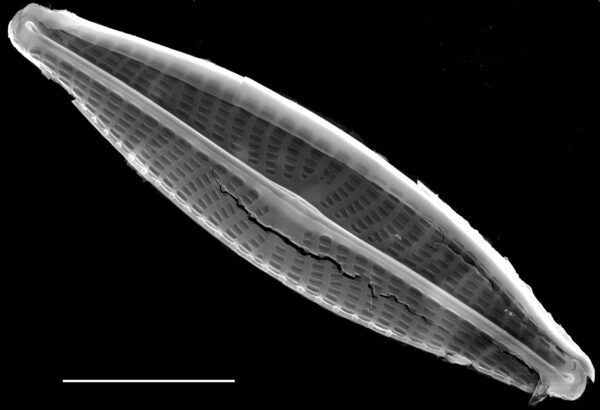Navicula notha
-
Category
-
Length Range18.7-39.3 µm
-
Width Range4.1-5.5 µm
-
Striae in 10 µm14-17
-
Reported AsNavicula heimansioides (Krammer and Lange-Bertalot 1991)
-
ContributorMarina Potapova - Feb 2011
-
ReviewerPat Kociolek - Apr 2011
Identification
Description
Valves are lanceolate to linear-lanceolate with slightly drawn-out ends. Axial area is narrow, central area is small, rhomboid to elliptical. Proximal raphe ends are noticeably deflected to the primary side. Striae are radiate and bent at valve center, convergent at apices, 14-17 in 10 μm. There are 36-40 lineolae in 10 μm.
Note that this concept of Navicula notha is different from that presented in Krammer & Lange-Bertalot (1991) and Lange-Bertalot (1993, 2001) who distinguished N. notha and N. heimansioides. Most studied populations of N. notha from USA, including the type population from Virginia, had both relatively small specimens that fit Lange-Bertalot's concept of N. notha (length equal or less than 32 μm) and large specimens fitting the concept of N. heimansioides (length equal or greater than 30 μm). A morphometric study across several USA populations failed to reveal any breaks in distribution of size and striae density. SEM examination of large and small specimens from the type material did not show any ultrastructural differences. Therefore, we consider N. heimansioides to be a part of N. notha.
Autecology
This taxon is characteristic of low alkalinity and low nutrient concentration.
-
Size Range, µm3
-
Motility
-
Attachment
-
Habitat
-
Colony
-
Occurrence
-
BCG
-
Waterbody
-
Distribution
- Learn more about this
Original Description
Valvis angustis lanceolatis 19-31 μ longis, 4-4.5 μ latis, prope apices paullo concavis, apicibus breve productis vel subcapitatis, striis medis radiantibus, terminalibus parallelis vel vix convergentibus, 16-17 in 10 μ.
-
AuthorJ.H.Wallace 1960
-
Length Range19-31 µm
-
Width4-4.5 µm
-
Striae in 10µm16-17
Citations & Links
Citations
Links
-
Index Nominum Algarum
-
North American Diatom Ecological DatabaseNADED ID: 46044
Cite This Page
Potapova, M. (2011). Navicula notha. In Diatoms of North America. Retrieved January 14, 2025, from https://diatoms.org/species/45864/navicula_notha
Responses
The 15 response plots show an environmental variable (x axis) against the relative abundance (y axis) of Navicula notha from all the stream reaches where it was present. Note that the relative abundance scale is the same on each plot. Explanation of each environmental variable and units are as follows:
ELEVATION = stream reach elevation (meters)
STRAHLER = distribution plot of the Strahler Stream Order
SLOPE = stream reach gradient (degrees)
W1_HALL = an index that is a measure of streamside (riparian) human activity that ranges from 0 - 10, with a value of 0 indicating of minimal disturbance to a value of 10 indicating severe disturbance.
PHSTVL = pH measured in a sealed syringe sample (pH units)
log_COND = log concentration of specific conductivity (µS/cm)
log_PTL = log concentration of total phosphorus (µg/L)
log_NO3 = log concentration of nitrate (µeq/L)
log_DOC = log concentration of dissolved organic carbon (mg/L)
log_SIO2 = log concentration of silicon (mg/L)
log_NA = log concentration of sodium (µeq/L)
log_HCO3 = log concentration of the bicarbonate ion (µeq/L)
EMBED = percent of the stream substrate that is embedded by sand and fine sediment
log_TURBIDITY = log of turbidity, a measure of cloudiness of water, in nephelometric turbidity units (NTU).
DISTOT = an index of total human disturbance in the watershed that ranges from 1 - 100, with a value of 0 indicating of minimal disturbance to a value of 100 indicating severe disturbance.

Navicula notha
- Valve lanceolate to linear-lanceolate
- Central area small
- Proximal raphe ends deflected to primary side
- Striae radiate and bent at center
- Striae convergent at apices
Valves are lanceolate to linear-lanceolate with slightly drawn-out ends. Valves are 4.1-5.5 μm wide. Axial area is narrow, central area is small, rhomboid to elliptical. Proximal raphe ends are noticeably deflected to the primary side. Striae are radiate and bent at valve center, convergent at apices, 14-17 in 10 μm. There are 36-40...
 Diatoms of North America
Diatoms of North America









